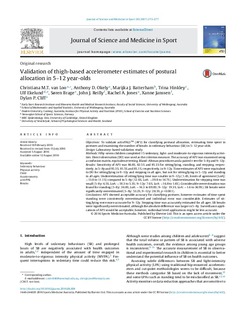| dc.description.abstract | Objectives: To validate activPAL3™ (AP3) for classifying postural allocation, estimating time spent in postures and examining the number of breaks in sedentary behaviour (SB) in 5–12 year-olds. Design: Laboratory-based validation study. Methods: Fifty-seven children completed 15 sedentary, light- and moderate-to-vigorous intensity activities. Direct observation (DO) was used as the criterion measure. The accuracy of AP3 was examined using a confusion matrix, equivalence testing, Bland–Altman procedures and a paired t-test for 5–8y and 9–12y. Results: Sensitivity of AP3 was 86.8%, 82.5% and 85.3% for sitting/lying, standing, and stepping, respectively, in 5–8y and 95.3%, 81.5% and 85.1%, respectively, in 9–12y. Time estimates of AP3 were equivalent to DO for sitting/lying in 9–12y and stepping in all ages, but not for sitting/lying in 5–12y and standing in all ages. Underestimation of sitting/lying time was smaller in 9–12y (1.4%, limits of agreement [LoA]: −13.8 to 11.1%) compared to 5–8y (12.6%, LoA: −39.8 to 14.7%). Underestimation for stepping time was small (5–8y: 6.5%, LoA: −18.3 to 5.3%; 9–12y: 7.6%, LoA: −16.8 to 1.6%). Considerable overestimation was found for standing (5–8y: 36.8%, LoA: −16.3 to 89.8%; 9–12y: 19.3%, LoA: −1.6 to 36.9%). SB breaks were significantly overestimated (5–8y: 53.2%, 9–12y: 28.3%, p < 0.001). Conclusions: AP3 showed acceptable accuracy for classifying postures, however estimates of time spent standing were consistently overestimated and individual error was considerable. Estimates of sitting/lying were more accurate for 9–12y. Stepping time was accurately estimated for all ages. SB breaks were significantly overestimated, although the absolute difference was larger in 5–8y. Surveillance applications of AP3 would be acceptable, however, individual level applications might be less accurate. | nb_NO |
